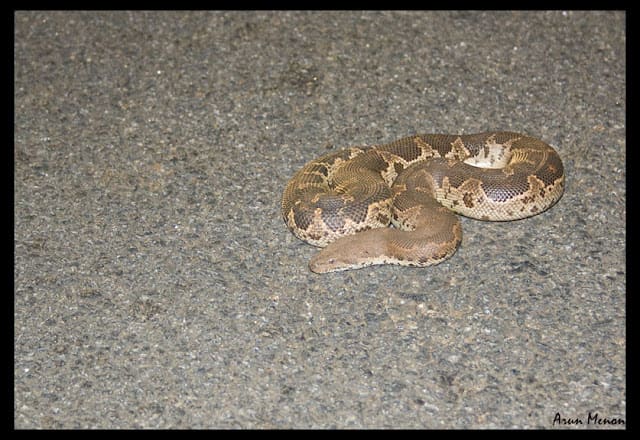 |
| The Sand Boa where we found it |
Khusro pulled over to the side and four of us ran back to the spot. In the available light Sunil and I tried to identify the snake. At first glance the stout body gave us the impression that it was a small Russell’s Viper. Peering closer, aided by the head light of an oncoming vehicle, we determined that it was a Common Sand Boa (Eryx conicus).
We had to prevent it from becoming another all-too-common roadkill. While I stopped vehicles speeding past us, Sunil took off his tshirt, draped it over the snake and lifted it off the road. He has been working with snakes for a while and was comfortable handling the boa. We then put the snake in front of Khusro’s vehicle. Under headlights, we checked it for injuries. It seemed all right.
 |
| The snake lashes out, trying to strike |
It was only my fourth touch of a snake, but this felt different. The sturdy, muscular serpent had rough, hard scales. True to its name the Sand Boa spends most of its life under the sand or in loose earth, and its tough skin offers protection while burrowing. Its scales were rougher and harder than that of the other three snakes I had handled. Boas are thick, short snakes with rough, keeled scales. Although individuals up to 90 centimetres have been measured, on an average they grow to around 60 centimetres.
 |
| Note the pattern on the back and the shape of the head |
The Sand Boa is often mistaken for the venomous Russell’s Viper and therefore killed. Other reasons for its declining numbers are the illegal trade in animals and poaching for its skin. These snakes are caught and sold as pets and their skin is coveted for making fancy purses and wallets.
Sand Boas are found in arid and semi-arid regions and are generally active at dusk and night. They are ovoviviparous, producing 3-16 live young. The breeding season is usually November.
 |
| Ready for release |
We took a few shots of the snake before releasing it away from the busy road. I have seen and heard snakes being run over. Yes, “heard”. The sound that is produced as a vehicle runs over a snake is a sickening snap. I am glad I didn’t have to hear it this time.
Text and photographs: Arun
- Savannah Sprinter – A day at the office with the cheetah - April 9, 2020
- Mangalajodi – birds and serenity in a winter wetland - April 14, 2018
- Let the sleeping tiger lie – on meeting the big cat on foot - March 13, 2017


